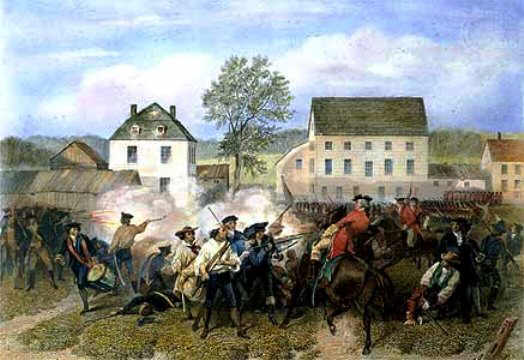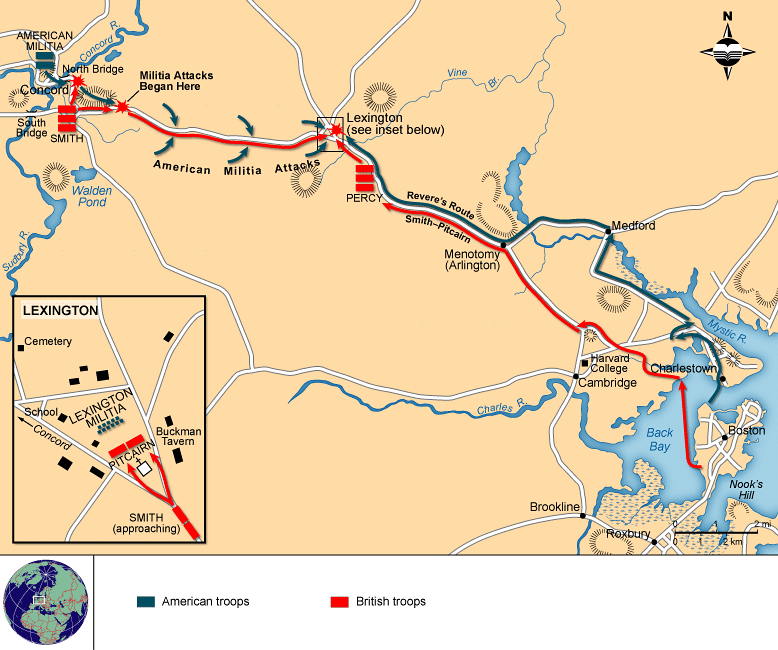Causes of the American Revolution:
Stamp act
The tax on the colonists was necessary to pay the cost of the British soldiers defending the colonies. Some colonists attacked the government stamp agents, lots of these colonists were part of the Sons of Liberty. The colonists are angered at being taxed directly by the British government because it was “taxation without representation”. The colonists did not feel need for British soldiers in the Thirteen Colonies.
https://en.wikipedia.org/wiki/Stamp_Act_1765
Townshend Act
The colonists are once again angered at being taxed directly by the British government because it was “taxation without representation”. British intent of proving its authority to tax colonies. Although it was repealed, tax on tea remained to protect British East India Company. The tax on the colonists was required to pay for the cost of operating the governments in the colonies so it was necessary. Britain had the authority to impose taxes on the colonies.

https://rootsoftherevolution7-3.wikispaces.com/The+Townshend+Acts
Boston Massacre
The American colonists were protesting and provoked the British soldiers by throwing rocks and snowballs at them. This resulted in an miss fire by a British soldier. In the confusion five unarmed colonist were shot and killed. It resulted in more hostility towards the British government. British soldiers involved were charged, tried and punished.

http://law2.umkc.edu/faculty/projects/ftrials/bostonmassacre/bostonmassacre.html
Tea Act and Boston tea party
The colonist opposed the Tea Act because it gave the British East India Company a monopoly on tea sales in the colonies. The Sons of Liberty destroyed tea on British ships to protest against Tea Act which was violent and illegal. The Tea Act made the price of tea cheaper so there should have been no reason for the American colonists to be upset. In

Inthttps://eighthgradehistory.wikispaces.com/The+Tea+Act+and+Boston+Tea+Partyolerable Acts
Intolerable Acts:
The colonists refused to pay for the tea they destroyed in Boston. The British government’s response to punish the colonists for the destruction of the tea in Boston was too extreme, harsh and unfair according to the Americans.

http://www.ushistory.org/us/9g.asp
First Continental Congress
The First Continental Congress was defying British authority. The colonists petition to repeal the Intolerable Acts was unreasonable especially since they refused to pay for the tea destroyed in Boston. King George rejected the colonists’ petition that demanded the Intolerable Acts be repealed.

Here is a painting to the meet between the colonist and king George
http://www.sonofthesouth.net/revolutionary-war/political/continental-congress.htm
Components:
Battle of Lexington and Concord April 19 175:
General Gage sent a detachment of 700 troops, with purposes of seizing and destroying artillery and ammunition. The Colonists already knew their weapons were in jeopardy and had moved most of them to secret locations. When the British arrived on the scene, someone fired a shot that would become known as “The Shot Heard Round’ the World”. By the time they finally had made it back to Boston, 73 Redcoats were killed and 174 were wounded. The American Revolution had officially begun.

This is a paining of the battle between the Americans and British
http://www.landofthebrave.info/revolutionary-battles.htm

This map shows the routes that both the Birtish and the Americans took for the first battle
http://www.kerryhawk02.com/2011_04_01_archive.html
Battle of Bunker Hill June 17 1775;
The Americans destination: BUNKER HILL. From this hill, the rebels could bombard the town and British ships in Boston Harbor. They went to BREED’S HILL by mistake. William Howe, leading the British forces, could have easily surrounded the Americans with his ships at sea, but instead chose to march his troops uphill. Howe might have believed that the Americans would retreat in the face of a smashing, head-on attack. he was wrong. By the time the third wave of British charged the hill, the Americans were running low on ammunition. Hand-to-hand fighting ensued. The British eventually took the hill, but at a great cost. Of the 2,300 British soldiers who had gone through the ordeal, 1,054 were either killed or wounded.

http://www.sonofthesouth.net/revolutionary-war/maps/battle-bunker-hill-map.htm

https://almostchosenpeople.wordpress.com/2010/07/26/battle-of-bunker-hill/
https://www.youtube.com/watch?v=E1o7BJ0Piu0#action=share
Thomas Paine’s Common Sense February 14 1776;
Despite taxes, times were good. Arguments can be made that average American was more prosperous than the average Briton. Yet there were the terrible injustices the colonists could not forget. Americans were divided against themselves. Arguments for independence were growing. Thomas Paine would provide the extra push. Common sense was a instant best selling book. In the end, his prose was common sense. Why should tiny England rule the vastness of a continent? How can colonists expect to gain foreign support while still professing loyalty to the British king? How much longer can Americans stand for the repeated abuses of the Crown? All these questions led many readers to one answer as the summer of 1776 drew near.

http://awakenings2012.blogspot.ca/2014/01/common-sense.html
Declaration of Independence July 4 1776;
More and more colonists felt deprived by the British not only of their money and their civil liberties, but their lives as well. On June 7, 1776, RICHARD HENRY LEE introduced a resolution to the Congress that declared the thirteen colonies “free and independent states.” Congress did not act on the resolution immediately. A vote was set for early July. Benjamin Franklin, John Adams and THOMAS JEFFERSON, was selected to choose the careful wording. Such a document must be persuasive to a great many parties. If the American effort was successful, they would be hailed as heroes. If it failed, they would be hanged as traitors.

Battle of Trenton December 26 1776;
General Washington planned an attack on the Hessians from three directions to be executed on December 26, 1776. In the battle, only two American soldiers were killed and five were injured, though many more suffered from hypothermia and disease. The Hessians suffered 83 casualties, 22 of which were fatalities. Washington’s army was soon joined by armies under the command of Generals Nathaniel Greene and John Sullivan.


https://en.wikipedia.org/wiki/Battle_of_Trenton
Battle of Saratoga October 7 1777;
British planned to cut off New England from the rest of the colonies by taking New York, Albany and the Hudson River. Generals Burgoyne, St. Leger and Howe would meet at Albany to defeat the rebel armies. Burgoyne’s army became trapped in Saratoga blocked by General Gates. October 7, 1777 Burgoyne attempted to attack the larger Patriot force,
Burgoyne’s army was defeated by Arnold’s army at Bemis Heights due to a lack of supplies and high casualties Burgoyne surrendered. Patriot victory at Saratoga was a turning point in the war. It renewed the morale of the Americans and convinced France the Americans could win the war and decided to support the Americans. France sent generals, troops, ships, supplies, money to help Americans win the war.


Battle of Camden August 16 1780
Birtish focus on the southern colonies. They gave command of a second southern army to Horatio Gates, the hero of the Battle of Saratoga. This action was taken without the consent of Commander-in-Chief George Washington. Of his 4,000 soldiers, at least half were ravaged by disease or exhaustion, rendering them unfit for service. The first retreat became contagious as other portions of Gates’ army began to flee before Gates himself fled from the battleground. Soon, the entire Patriot army fled. Patriots a thousand were captured and 900 were killed or wounded. The army’s artillery and baggage train were also captured.

Consequences of the Revolution:
Treaty of Paris:
Britain agreed to recognize American independence. They gave Americans fishing rights to the Grand Banks off the coast of Newfoundland. Britain granted U.S. all territory between Allegheny Mountains on the east and Mississippi River on the west.

Here is part of the treaty
http://www.ourdocuments.gov/doc.php?doc=6
Loyalist:
Approximately 20% of American colonists supported British rule and remained loyal
Loyalists. They were persecuted by the Patriots during the war. Patriots abused them and burned their homes and farms. After the revolution and Treaty of Paris was signed, between 80,000-100,000 Loyalists had to leave U.S. . Many settled in other British colonies in North America – Quebec, Nova Scotia and Island of St. John (PEI).

The loyalists still belied in there British monarch, and continued to follow the monarchs words despite the other Americans
http://revolutionbuddies.weebly.com/loyalists.html
Constitution 1789:
The Constitution outlines the structure and powers of government. Three branches of government are separate, checked and balanced off by the power of the other two. U S Constitution is supreme. All persons are equal before the law, people can change the constitution.

This is a copy of the Constitution
Bill https://alittletourinyellow.wordpress.com/2012/03/29/judging-the-united-states-supreme-court/of Rights:
The first 10 amendments (additions) of the constitution represent ideals regarding individual liberty, limited government, and the rule of law.
Worldwide Influence:
American Revolution spread ideas of liberty, individual rights and equality to other parts of the world. It influenced and inspired other revolutions around the world such as France in 1789. American Declaration of Independence had some impact on the French Declaration of the Rights of Man and the Citizen of 1789.

The influence spread far and wide all over the world
http://www.mapsofworld.com/world-map-image.html
Battle of Guildford Courthouse March 15 1781;
Charles Cornwallis resolved to\ destroy the continental army. Cornwallis decided to attack despite the fact he had less soldiers than Greene. Cornwallis army had 1,900 soldiers, Greene had 4,500 soldiers. At 1:30pm on March 15, 1781, the battle started. British army forced Greene’s first two lines to retreat. Battle lasted less than 2 1/2 hours, Cornwallis army reduced by over 25% . Cornwallis led his army to Yorktown, Virginia in hope to make a bigger army. Yorktown was the mighty siege for his army, american and French forces that would lead to the war’s end.
Battle of Yorktown October 6-19 1781;
A major objective of the French-American forces were to liberate New York City. September 1781, combined forces of Rochambeau and Washington marched south. End of September american forces trapped Cornwallis in the west. Comte de grasses navel forces trapped Cornwallis in the east. A siege had begun. October 6, 1781, american and French guns were spraying bullets in the British defences from land and water. Cornwallis had finally surrendered. Americans took over 7000 troops prisoner, the war was coming to an end. Yorktown would be the last major battle of the war.

On the left on this painting is the French surrendering to the English
http://americanrevolutionbymona.weebly.com/components.html
